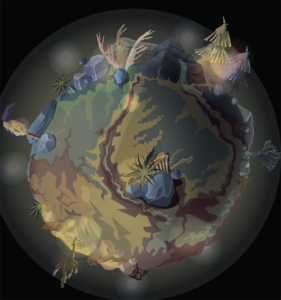HUMANISM 101 | There Is No “Planet B”

Both the delicacy and the resilience of life on earth are amazing. Just think—we know of at least five mass global extinction events: the O-C extinction 450–440 million years ago (in geology-speak, mega-annum, or Ma), which resulted in 70 percent of all species dying out; the Late Devonian extinction 375–360 Ma, which also claimed 70 percent; the Permian–Triassic extinction 252 Ma—this was the big one, resulting in 90–96 percent of all species disappearing; the Triassic–Jurassic event 201 Ma resulting in 75 percent global extinction; and the K-Pg (or KT) extinction around 66 Ma that wiped out the dinosaurs, as well as 75 percent of all species. It opened the door for mammals to thrive.
Massive die-offs can occur quite quickly, and global climate change due to volcanic explosions is the most likely cause. Things may be rocking along nicely for eons, and then, bam! Game over for the majority of species. These cataclysmic events are not the subject of apocalyptic movies, fantasy, or paranoid visions, but of fact. Ninety-nine percent of all species have gone extinct.
Around seventy-thousand years ago, humans declined rapidly. Humans are one of the most genetically similar species because we went through a “bottle neck” of extinction. Again, a volcano may have resulted in a quick change in climate that brought us to approximately 10,000 to 1,000 breeding adults. One study says we may have hit as low as forty individual. Humans struggled for thousands of years to make a comeback, and for a time there, says science writer Sam Kean, “We damn near went extinct.”
Only thirty thousand years ago there were at least four hominids walking the earth. Homo sapiens sapiens is the only species left. We domesticated plants and animals only around 12,000 BCE, which led to the building of cities and the beginning of civilization.
In this relatively brief amount of time we have developed huge metropolises, set foot on the moon, created democracy, and, indeed, created the integrated life stance of humanism. History tells us it is all fragile.
The great Mayan civilization collapsed and disappeared because of their love of architecture. They deforested the land to supply wood to fire the ovens to make mortar to build the pyramids. Deforestation resulted in 60 percent of the total drought that occurred over a century and the Mayan culture collapsed.
Today, every single one of the cabinet members in Donald Trump’s administration is a climate-change denier, and it’s not because they’re stupid. They are ideologically bound by religion in most cases. In my exercise class a woman told me she didn’t believe in human-caused climate change because her preacher told her it wasn’t true and that God would never let that happen until the apocalypse. When I asked if her preacher was a climate scientist she stared in disbelief at my skepticism.
The reality is that most of the climate-change denial is from fundamentalists and certain wealthy libertarian types like the Koch brothers. The vast majority of seculars and liberal or moderate religious people understand the science and the danger, and they’re committed to protecting the earth and all of its people. The political roadblocks the climate-change deniers present are significant. We want to remain tolerant of all beliefs, but beliefs have considerable consequences in this case. Religion based on blind faith is easily wedded with the pseudoscience of climate-change denial. Many studies have shown that a lack of critical thinking is easily expansive into many areas.
Let’s remember how fragile the earth is. Species and civilization, even ours, can be quickly wiped out. The universe may not care if we continue existing or not, but we do. And we don’t want to just survive, we want to thrive. Make no mistake that we are all at fault with every self-interested decision we make, yet it is imperative that humanity breaks free of the theological binds that constrain us from acting to prevent another mass extinction event.
